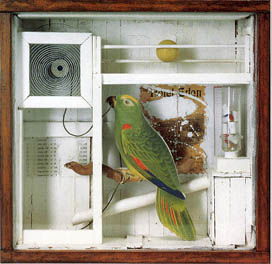portals

week two (jan. 12 & 15)
"The great mystery of adaptation is that fidelity can only be achieved through lavish promiscuity."
--David Hare
Intro to The Hours screenplay
Below are listed a few examples of Cornell boxes. They come from two books: Joseph Cornell, edited by Kynaston McShine and Joseph Cornell: Master of Dreams by Diane Waldman. All of the Cornell boxes linked below are untltled. The names are for identification only.
1. Parrotbox [also shown above right]
2. Eggmatches
3. Corkballs
4. Hanglobster
5. Compartments
6. Bacall
As was noted in class, TRANSFORMATION (both concept and practice) is central to an understanding of what distinguishes the stage from film and television. Other than animation, which we'll discuss in a later week, transformation is, at most, the rare exception on the screen. Please bear this in mind as you read The Hours screenplay and excerpts from the novel.
Also, here are a few other questions and observations to ponder:
1. How the screenwriter David Hare handle with time and space in The Hours?
2. By contrast, how does Paula Vogel handle time and space in How I Learned to Drive? What is different about Vogel's approach? How does this difference affect the audience? What does it demand of the performers?
3. There are 22 chapters and a prologue in the Cunningham novel compared to dozens of scenes in the screenplay. Beyond the obvious, what do you make of this?
4. In what ways do Murray's "basic distinctions" between stage and screen apply to The Hours and to How I Learned to Drive?
REMINDER --- Saturday morning screening (Jan. 15 in Rm A1107):
The Hours at 10 am
Other suggested readings:
Hurt. Focus on Film and Theatre
Murray. The Cinematic Imagination
